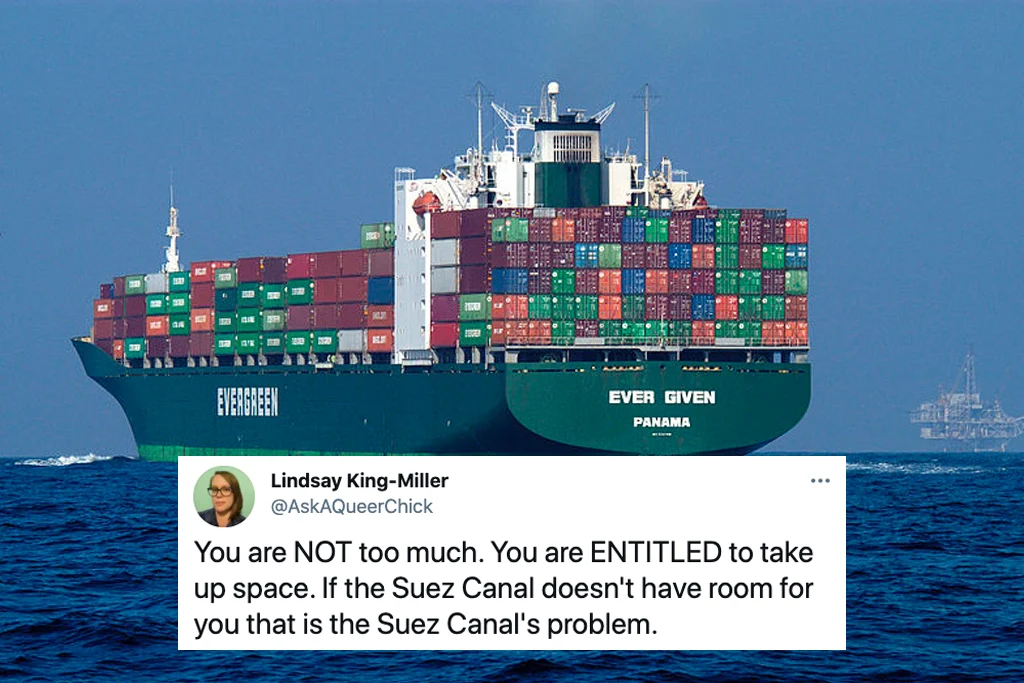Some parts of the country are experiencing versions of springtime for the first, second or third time this year (if your weather keeps changing between freezing rain and 60 degrees — looking at you, Missouri and Illinois), and with that come things to get you out of the house. It’s the best time of the year when the sun comes out, but it’s still a little too early to do any real yardwork.
All of this to say the best way to get out of the house is joining the first IN-PERSON FreightWaves event of the year: The Future of Supply Chain. It’s May 9-10, a Monday and Tuesday, and for those who are quick on the draw there are ticket specials, like a coupon to come hang out with the coolest people you know. Just click the banner and you could get the coupon!
And don’t forget about the 3PL Summit on March 16! You don’t have to leave your house/office/chair/bed for this one. Consider it your pre-game for St. Patrick’s Day!
Now back to regularly scheduled business …
Hot Take

Tuesday we covered pro tips from the life of a former broker and load planner. Today we’re switching it up; we’re looking at the need to have info from the carrier side of things for both dry van shipments and reefer shipments. We don’t always remember what goes through the carrier perspective; it’s good to stop and remind ourselves that carriers are people too.
I chatted with St. Louis-based Hogan Transportation about things that make individual brokers appealing from the carrier perspective.
FREIGHTWAVES: As a carrier, what things do you wish to know about when starting to work with a new brokerage?
HOGAN TRANSPORT: “When starting with a new client, it’s important to know how long they have been in business, what their payment terms are, their expectations from a transportation partner, who handles shipping/receiving, and most importantly their freight specifications. Another important factor is their IT integration for load tendering, tracking, scheduling and billing. Simplification of the entire process benefits both the transporter and the customer.”
FREIGHTWAVES: What are the struggles you have with new brokers in the industry?
HOGAN TRANSPORT: “Operational experience and expertise are important attributes to being a successful broker. It is important that new brokers understand the various trucking markets and costs associated with them. It is equally important that they understand the driver market.
“The driver market has changed the 3PL landscape. Over-the-road (OTR) drivers are transferring to regional turn runs that allow them more home time with their family. Recruiting and retaining OTR drivers requires higher wages, which increase customer rates. It takes a lot of knowledge to be successful in the broker market, which takes time to absorb.”
FREIGHTWAVES: What are the most important things you need to be successful with reefer shipments?
HOGAN TRANSPORT: “Communication from the customer and broker of the exact product, including processing, packaging, handling during pickup or delivery. Another major point is clarification if orders have both temperate (35-plus degrees) and frozen (32 degrees or below) products. Not only that but is the bulkhead required, and who is responsible for the bulkhead and reefer unit temperature-tracking capabilities.
“The value of the shipment should be communicated prior to the order assignment to make sure cargo insurance limitations are met. To ensure that a temp-controlled load is delivered per consignee expectations, drivers are required to confirm the temperature listed on the bill of lading prior to signing the BOL at the shipper. The temperature listing on the BOL is non-negotiable.
“Specifics are KEY. For example, there is a vast difference between ‘Frozen 32 Degrees’ and ‘Frozen -10 Degrees,’ especially when the load is rejected at the consignee for not being run at the required temperature.”
The biggest takeaway for those starting out or looking to develop their skills is to do your homework. Take the time to learn the markets through all the amazing tools out there (I’m partial to SONAR, but you do you), and ask shippers and carriers even questions that may seem obvious. The last thing you want is some detail getting missed because it was just assumed everyone knew the answer. No matter how simple it may seem, never be afraid to ask.
Quick Hits

Remember that time the Suez Canal was blocked for six days and world trade came to a screeching halt? Yeah, good times. The Suez Canal is back in the spotlight, not for a massive ship being stuck, but instead for a canal toll. Now I personally did not know the Suez Canal had tolls, but if land-based highways can impose tolls, it makes perfect sense that a water-based one could.
Full and empty vessels traversing the canal are getting hit with a 5%, 7% or 10% increase in tolls — the price hike will depend on the carrier type. The only exceptions to this toll are liquefied natural gas vessels and cruise ships. Now 5% might not seem like a lot, but it comes to tens of thousands of dollars on, say a one-way transit that ordinarily costs an already-high $625,000.
If you have customers that utilize a lot of container shipping, it’s time to have those conversations and work on proactive measures, whether it’s booking on ships going around the Horn of Africa, adding more time to a shipment, or just saving the time and paying the price. Either the tolls or the fuel prices for longer sailings will be the key indicator in decision-making.
West Coast port congestion is down: We’re hovering around the 70-60 number of ships waiting for berths in San Pedro Bay. Ships have diverted to the East Coast or taken a break as a result of the Chinese Lunar New Year. Things have been looking up for the ports. Until now.

Guess what year it is. It’s the year to renegotiate the West Coast International Longshore and Warehouse Union contract. Currently that bad boy is set to expire at the end of June, but about four dozen of our closest friends have politely asked the White House to get involved in the negotiations now, so we can avoid breaking the recent record 109 ships waiting for berths. The contract covers all ports on the West Coast from San Diego to Seattle.
Automation and higher compensation are expected to be the top agenda items, with port operators interested in technology to address inefficiencies contributing to COVID-related backlogs and labor seeking a cut of record profits by ocean carriers, which control many terminals. I mean, who doesn’t remember the pictures from 2014 showing containers of fresh produce rotting in the summer heat?
Here’s hoping they get things resolved quickly, because we cannot handle another work slowdown or lockout.
TRAC Thursday

Go west, young man, but only west, not northwest. The Pacific Northwest is having a bit of a rainy moment and has decided to remove itself from the conversation. State roads are flooded out, pavement is damaged, and roads are just casually blocked by entire trees. As a result of Mother Nature’s delight, officials have been forced to close major state highways to all traffic. For an area that is used to the rain, this is a bit more than the usual.
Despite those massive road disruptions the spot market hasn’t caught up to the weather. The FreightWaves TRAC rate for Medford, Oregon, to Olympia, Washington, is coming in at $6.15 per mile. To those not super familiar with that region, the rate may seem quite high but is actually on the low side. In fact, it is one of the lowest rates in the past three months. Road conditions in certain areas may cause some out-of-route miles, but it’s still a great time, ratewise, to get those loads booked and get shippers moving their freight.
Who’s with whom

Regional LTL carrier Dayton Freight Lines announced the acquisition of a cartage division of a longtime partner carrier, Valley Cos. Valley is a regional transportation and logistics provider based in Hudson, Wisconsin. The deal includes terminals, trucks, related equipment and workers. The logistics and warehousing components of Valley Cos. are not included. This deal will allow Dayton Freight to provide direct coverage to all of Minnesota.
Railcar manufacturer Greenbrier got a new CEO, Lorie Tekorius. It was announced last year she would be taking over the role. Tekorius’ previous positions were COO, president and CFO. As a walking model for Greenbrier’s company values, Tekorius is sure to capably lead the company through the unprecedented challenges the entire supply chain world is experiencing.
The more you know
Special March Madness offer available for FreightWaves’ Future of Supply Chain
Shipping world stands with Ukraine
Biden bans Russian aircraft from US airspace
Trucking, logistics companies unite to raise money for Ukrainians
Shipping isn’t waiting for sanctions. It’s refusing to move Russian cargo











